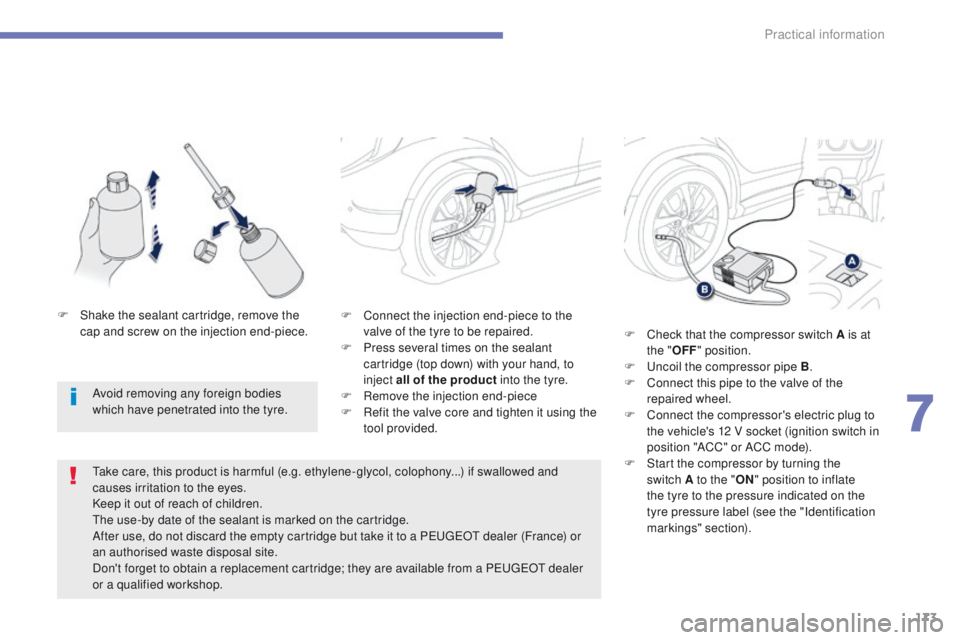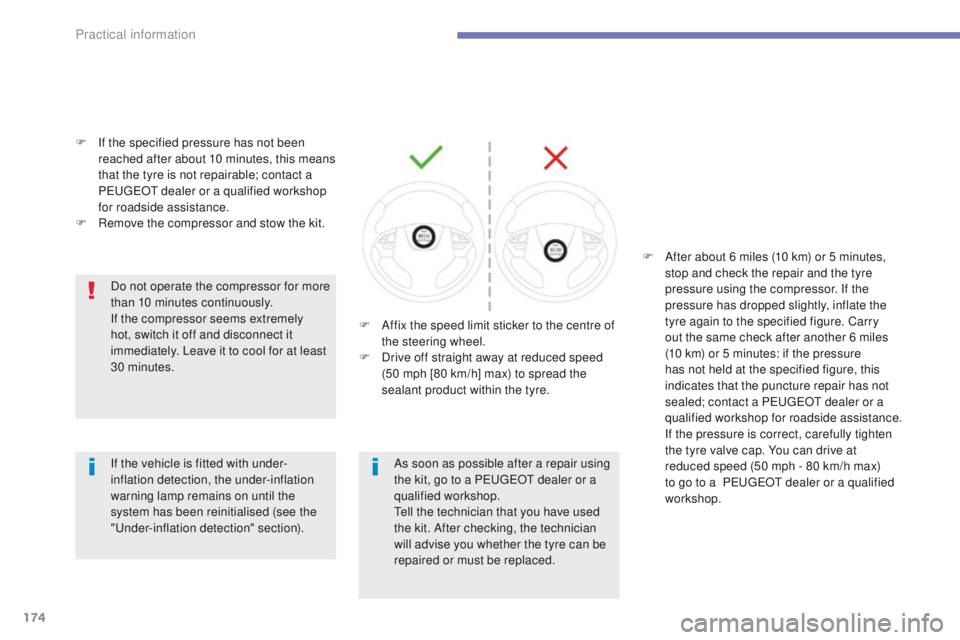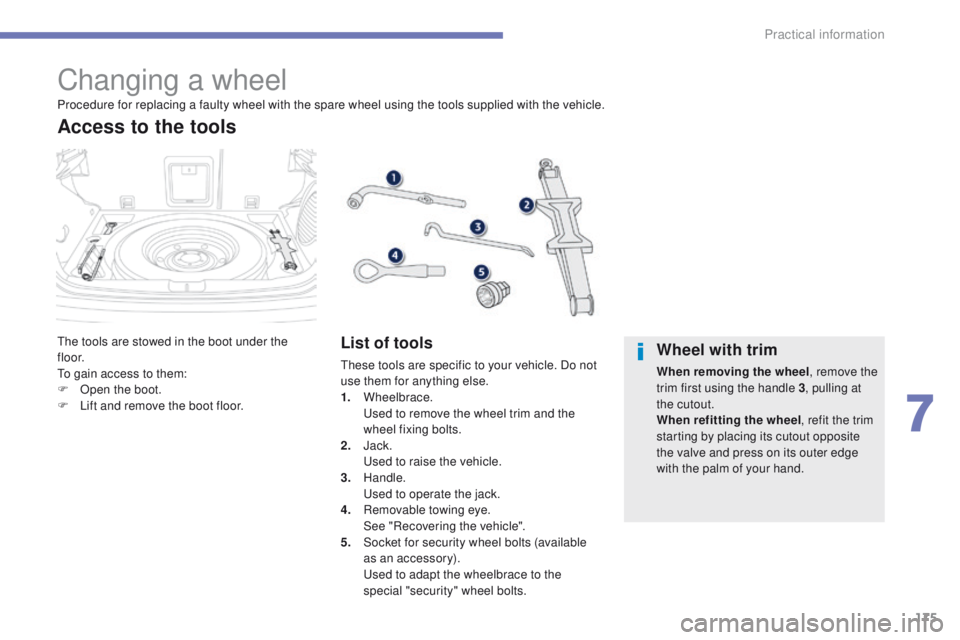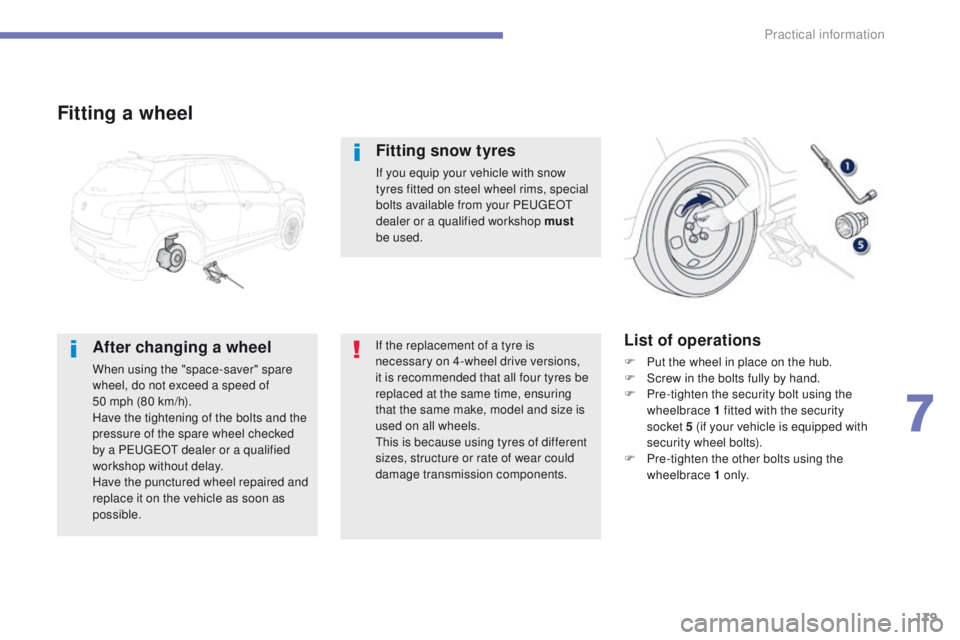Page 175 of 389

173
F Connect the injection end-piece to the valve of the tyre to be repaired.
F
P
ress several times on the sealant
cartridge (top down) with your hand, to
inject all of the product into the tyre.
F
R
emove the injection end-piece
F
R
efit the valve core and tighten it using the
tool provided.
ta
ke care, this product is harmful (e.g. ethylene-glycol, colophony...) if swallowed and
causes irritation to the eyes.
Keep it out of reach of children.
th
e use-by date of the sealant is marked on the cartridge.
After use, do not discard the empty cartridge but take it to a P
e
uge
Ot
dealer (France) or
an authorised waste disposal site.
Don't forget to obtain a replacement cartridge; they are available from a P
e
uge
Ot
dealer
or a qualified workshop. F
C
heck that the compressor switch A is at
the " OFF" position.
F
u
n
coil the compressor pipe B.
F
C
onnect this pipe to the valve of the
repaired wheel.
F
C
onnect the compressor's electric plug to
the vehicle's 12 V socket (ignition switch in
position "ACC" or ACC mode).
F
S
tart the compressor by turning the
switch
A to the "ON" position to inflate
the tyre to the pressure indicated on the
tyre pressure label (see the "Identification
markings" section).
Avoid removing any foreign bodies
which have penetrated into the tyre.
F
S
hake the sealant cartridge, remove the
cap and screw on the injection end-piece.
7
Practical information
Page 176 of 389

174
F If the specified pressure has not been reached after about 10 minutes, this means
that the tyre is not repairable; contact a
P
e
uge
Ot
dealer or a qualified workshop
for roadside assistance.
F
R
emove the compressor and stow the kit.Do not operate the compressor for more
than 10 minutes continuously.
If the compressor seems extremely
hot, switch it off and disconnect it
immediately. Leave it to cool for at least
30 minutes.
As soon as possible after a repair using
the kit, go to a P
e
uge
Ot
dealer or a
qualified workshop.
te
ll the technician that you have used
the kit. After checking, the technician
will advise you whether the tyre can be
repaired or must be replaced.
If the vehicle is fitted with under-
inflation detection, the under-inflation
warning lamp remains on until the
system has been reinitialised (see the
"
un
der-inflation detection" section). F
A
ffix the speed limit sticker to the centre of
the steering wheel.
F
D
rive off straight away at reduced speed
(50 mph [80 km/h] max) to spread the
sealant product within the tyre. F
A
fter about 6 miles (10 km) or 5 minutes,
stop and check the repair and the tyre
pressure using the compressor. If the
pressure has dropped slightly, inflate the
tyre again to the specified figure. Carry
out the same check after another 6 miles
(10 km) or 5 minutes: if the pressure
has not held at the specified figure, this
indicates that the puncture repair has not
sealed; contact a P
e
uge
Ot
dealer or a
qualified workshop for roadside assistance.
I
f the pressure is correct, carefully tighten
the tyre valve cap. You can drive at
reduced speed (50 mph - 80 km/h max)
to go to a
P
e
uge
Ot
dealer or a qualified
workshop.
Practical information
Page 177 of 389

175
Changing a wheel
the tools are stowed in the boot under the
f l o o r.
to g
ain access to them:
F
O
pen the boot.
F
L
ift and remove the boot floor.
Access to the tools
List of tools
these tools are specific to your vehicle. Do not
use them for anything else.
1.
Wheelbrace.
u
s
ed to remove the wheel trim and the
wheel fixing bolts.
2.
J
ack.
u
se
d to raise the vehicle.
3.
Handle.
u
s
ed to operate the jack.
4.
R
emovable towing eye.
S
ee "Recovering the vehicle".
5.
S
ocket for security wheel bolts (available
as an accessory).
u
s
ed to adapt the wheelbrace to the
special "security" wheel bolts.
Procedure for replacing a faulty wheel with the spare wheel using the tools supplied with the vehicle.Wheel with trim
When removing the wheel
, remove the
trim first using the handle 3 , pulling at
the cutout.
When refitting the wheel , refit the trim
starting by placing its cutout opposite
the valve and press on its outer edge
with the palm of your hand.
7
Practical information
Page 178 of 389
176
the spare wheel is installed in the boot under
t h e f l o o r.
Depending on version, the spare wheel may be
a standard size steel or alloy wheel, or for some
countries it is the "space saver" type.
For access to the spare wheel, see "Access to
t he to o ls".
Access to the spare wheel
Taking out the standard wheel
F unscrew the central bolt A.
F R aise the spare wheel towards you from
the rear.
F
t
a
ke the wheel out of the boot.
Putting the standard wheel
back in place
F Put the wheel back in its housing.
F P ut the central bolt A in place in the centre
of the wheel.
F
t
i
ghten fully to retain the wheel correctly.
Practical information
Page 179 of 389
177
Removing a wheel
Parking the vehicle
Immobilise the vehicle where it does not
block traffic: if possible, park the vehicle
on level, stable and non-slippery
ground.
Apply the parking brake, switch off the
ignition and engage first gear to lock
the wheels.
If necessary, place a chock under the
wheel diagonally opposite the wheel to
be changed.
Never go underneath a vehicle raised
using a jack; use a stand.
List of operations
F If your vehicle is equipped with security wheel bolts (equipment available as an
accessory) fit the security socket 5 on the
wheelbrace 1 to slacken the security bolt.
F
S
lacken the other bolts using the
wheelbrace 1 o n l y.
7
Practical information
Page 180 of 389
178
F Place the jack 2 in contact with one of the two front A or rear B locations provided on
the underbody, whichever is closest to the
wheel to be changed.
F
e
x
tend the jack 2 until its base plate is in
contact with the ground.
e
n
sure that the
centreline of the jack base plate is directly
below the location A or B used. F
Ra ise the vehicle until there is sufficient
space between the wheel and the ground
to admit the spare (not punctured) wheel
easily.
F
R
emove the bolts and store them in a
clean
place.
F
R
emove the wheel.
Practical information
Page 181 of 389

179
Fitting a wheel
After changing a wheel
When using the "space-saver" spare
wheel, do not exceed a speed of
50 mph (80 km/h).
Have the tightening of the bolts and the
pressure of the spare wheel checked
by a P
e
uge
Ot
dealer or a qualified
workshop without delay.
Have the punctured wheel repaired and
replace it on the vehicle as soon as
possible.
List of operations
F Put the wheel in place on the hub.
F S crew in the bolts fully by hand.
F
P
re-tighten the security bolt using the
wheelbrace 1 fitted with the security
socket
5 (if your vehicle is equipped with
security wheel bolts).
F
P
re-tighten the other bolts using the
wheelbrace 1 o n l y.
Fitting snow tyres
If you equip your vehicle with snow
tyres fitted on steel wheel rims, special
bolts available from your P
e
uge
Ot
dealer or a qualified workshop must
be
used.
If the replacement of a tyre is
necessary on 4-wheel drive versions,
it is recommended that all four tyres be
replaced at the same time, ensuring
that the same make, model and size is
used on all wheels.
th
is is because using tyres of different
sizes, structure or rate of wear could
damage transmission components.
7
Practical information
Page 182 of 389
180
F Lower the vehicle fully.
F F old the jack 2 and detach it. F
ti ghten the security bolt using the
wheelbrace 1 fitted with the security
socket
5 (if your vehicle is equipped with
security wheel bolts).
F
t
i
ghten the other bolts using the
wheelbrace 1 o n l y.
F
S
tore the tools (refer to the paragraph
"Access to the tools").
Practical information